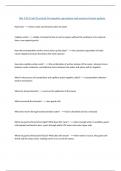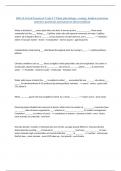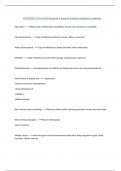Bio 1414 - Study guides, Class notes & Summaries
Looking for the best study guides, study notes and summaries about Bio 1414? On this page you'll find 41 study documents about Bio 1414.
All 41 results
Sort by

-
BIO 1414 UPDATED Questions and CORRECT Answers
- Exam (elaborations) • 19 pages • 2024
-
- $8.99
- + learn more
The hypothesis of punctuated equilibrium was based on what model for speciation? - peripatetic speciation What is true microevolution? - it is the kind of evolution that can change the relative abundance of a particular allele in a gene pool over the course of generations A relatively small number of Amish immigrants came to this country in the 1700's. They have since greatly increased their number while remaining largely segregated from the rest of the population. Polydactyly (having ...
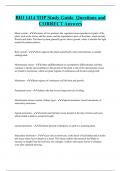
-
BIO 1414 TOP Study Guide Questions and CORRECT Answers
- Exam (elaborations) • 19 pages • 2024
-
- $8.99
- + learn more
Shoot system - consists of two portions: the vegetative (non-reproductive) parts of the plant, such as the leaves and the stems, and the reproductive parts of the plant, which include flowers and fruits. The shoot system generally grows above ground, where it absorbs the light needed for photosynthesis. Root system - which supports the plants and absorbs water and minerals, is usually underground. Meristematic tissue - either undifferentiated or incompletely differentiated, and they ...
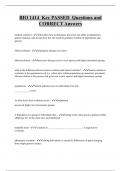
-
BIO 1414 Key PASSED Questions and CORRECT Answers
- Exam (elaborations) • 9 pages • 2024
-
- $7.99
- + learn more
modern synthesis - describes how evolutionary processes can affect a population'a genetic makeup, and, in turn how this can result in gradual evolution of populations and species Microevolution - population changes over time Macroevolution - processes that gave rise to new species and higher taxonomic groups what is the difference between microevolution and macroevolution? - microevolution is evolution at the population level (i.e. where tarts within populations get more/less prevalent...

-
BIO 1414 Certification Questions and CORRECT Answers
- Exam (elaborations) • 8 pages • 2024
-
- $7.99
- + learn more
How is the field of Biology organized hierarchically? - Evolution - the process of change that has transformed life on earth Adaption - the change over generations to better fir the environment both behavioral and physical How does natural selection work? - -Individuals compete for limited resources to survive -Some have better chance than others -Varieties with increased chance in survival continue to reproduce and pass on genes -Greater number in next generation have the characteristi...

-
OCCC BIO 1414 A&P 2: Urinary, Reproductive System Exam.
- Exam (elaborations) • 13 pages • 2023
-
- $12.83
- + learn more
Function of Nephrons filtration, reabsorption, secretion Density of urine 1.001-1.028 pH of Urine 4.5 to 8.2, usually 6.0 (mildly acidic) Kidney Filters waste from the blood like urea, water, salt and proteins. adrenal glands a pair of endocrine glands that sit just above the kidneys and secrete hormones (epinephrine and norepinephrine) that help arouse the body in times of stress.
Bio 1414 Lab Practical II complete questions and answers latest update.
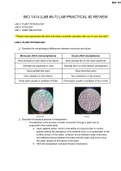
-
BIO 1414 (LAB #5-7) LAB PRACTICAL #2 2021-2022 REVIEW with practice questions Updated
- Other • 17 pages • 2022
-
- $13.49
- + learn more
BIO 1414 (LAB #5-7) LAB PRACTICAL #2 REVIEW LAB 5: PLANT PHYSIOLOGY LAB 6: ECOLOGY LAB 7: HABIT SELECTION **Please wear appropriate lab attire and bring a scientific calculator with you on your test day!** LAB 5: PLANT PHYSIOLOGY Describe the morphological differences between monocots and dicots Monocots (AKA monocotyledons) Dicots (AKA dicotyledons) Have stomata on both sides of the leaves Most stomata are on the lower epidermis Stomata are organized in rows Stomata are in a more rand...
BIO 1414 Lab Practical 2 Lab 5-7 Plant physiology, ecology, habitat selection practice questions and
UTSA BIO 1414 Lab Practical 2 passed written complete solution
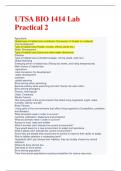
-
UTSA BIO 1414 Lab Manifest Academic Mastery.
- Exam (elaborations) • 4 pages • 2023
-
- $13.49
- + learn more
Water Development Type of habitat loss (Dams and other water diversions) Pollution Type of habitat loss (untreated sewage, mining waste, acid rain) Global Warming Emerging driver of habitat loss (Rising sea levels, and rising temperatures) Main drivers of habitat loss -agriculture -land conversion for development -water development -pollution -global warming Brine shrimp when swimming: Become solitary while swimming and don't bump into each other. Brine shrimp phylogeny Phylum: A...

$6.50 for your textbook summary multiplied by 100 fellow students... Do the math: that's a lot of money! Don't be a thief of your own wallet and start uploading yours now. Discover all about earning on Stuvia



